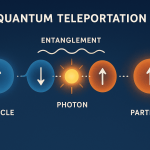A World Desperate for Clean Energy
With climate change accelerating and fossil fuels depleting, the world is in desperate need of a game-changing energy source. Solar and wind are promising, but they have limits—like weather dependency and land use. What if we could power our world with the same energy that fuels the Sun?
Enter fusion energy—a clean, virtually limitless power source that could revolutionize how we power our lives. But can it really deliver on its promise?
What Is Fusion, and How Is It Different?
Nuclear fusion is the process of combining two light atomic nuclei (like hydrogen) into one heavier nucleus (like helium), releasing massive amounts of energy in the process. This is the opposite of nuclear fission, which splits atoms (as in today’s nuclear reactors) and creates radioactive waste.
Here’s what makes fusion different—and better:
- No long-lived nuclear waste
- No carbon emissions
- No meltdown risk
- Fuel from seawater (like deuterium)
- Virtually unlimited energy supply
It’s the same process that powers stars. If we can replicate that on Earth, we unlock a future of clean, safe, and reliable energy.
How Does a Fusion Reactor Work?
There are two main approaches:
1. Magnetic Confinement (e.g., Tokamak)
- Super-hot plasma (over 100 million °C) is trapped using magnetic fields inside a doughnut-shaped chamber.
- The most famous example? ITER in France—an international mega-project set to demonstrate net fusion energy by the 2030s.
2. Inertial Confinement
- Powerful lasers blast fuel pellets to compress them and trigger fusion.
- Used in labs like Lawrence Livermore National Lab (USA), which achieved a major milestone in 2022 by briefly producing more energy than the input.
Other companies, like Helion Energy, Commonwealth Fusion Systems, and TAE Technologies, are racing to develop smaller, commercial reactors with innovative approaches.
Recent Breakthroughs
In the past few years, fusion has gone from “forever 30 years away” to practically possible:
- Lawrence Livermore Lab achieved “ignition” — more energy out than in — for a fraction of a second.
- Private fusion startups raised billions in funding.
- New superconducting magnets (developed by MIT) could shrink fusion plants dramatically.
Even Microsoft signed a deal with Helion to buy fusion energy by 2028—a bold vote of confidence.
The Challenges Ahead
Fusion is no magic wand. Major hurdles still remain:
- Sustaining the plasma long enough to extract usable energy
- Cost of building and maintaining reactors
- Converting fusion energy into electricity efficiently
- Scaling the technology for global use
But the momentum is building. What was once science fiction is now a global engineering challenge.
Why Fusion Could Be a Game-Changer
If successful, fusion could:
- Power entire cities with zero carbon emissions
- Replace coal, gas, and even current nuclear power
- Revolutionize space travel with compact reactors
- Free nations from energy dependence and oil politics
- Solve energy poverty with abundant, affordable electricity
It’s clean, safe, and limitless. That’s not just exciting—that’s civilization-changing.
Final Thoughts
Fusion energy is not just another tech trend. It’s humanity’s shot at mimicking the Sun to solve our biggest problems. While it’s not here yet, it’s no longer science fiction either. With enough investment, innovation, and international cooperation, fusion could become the ultimate clean power source of the 21st century.



